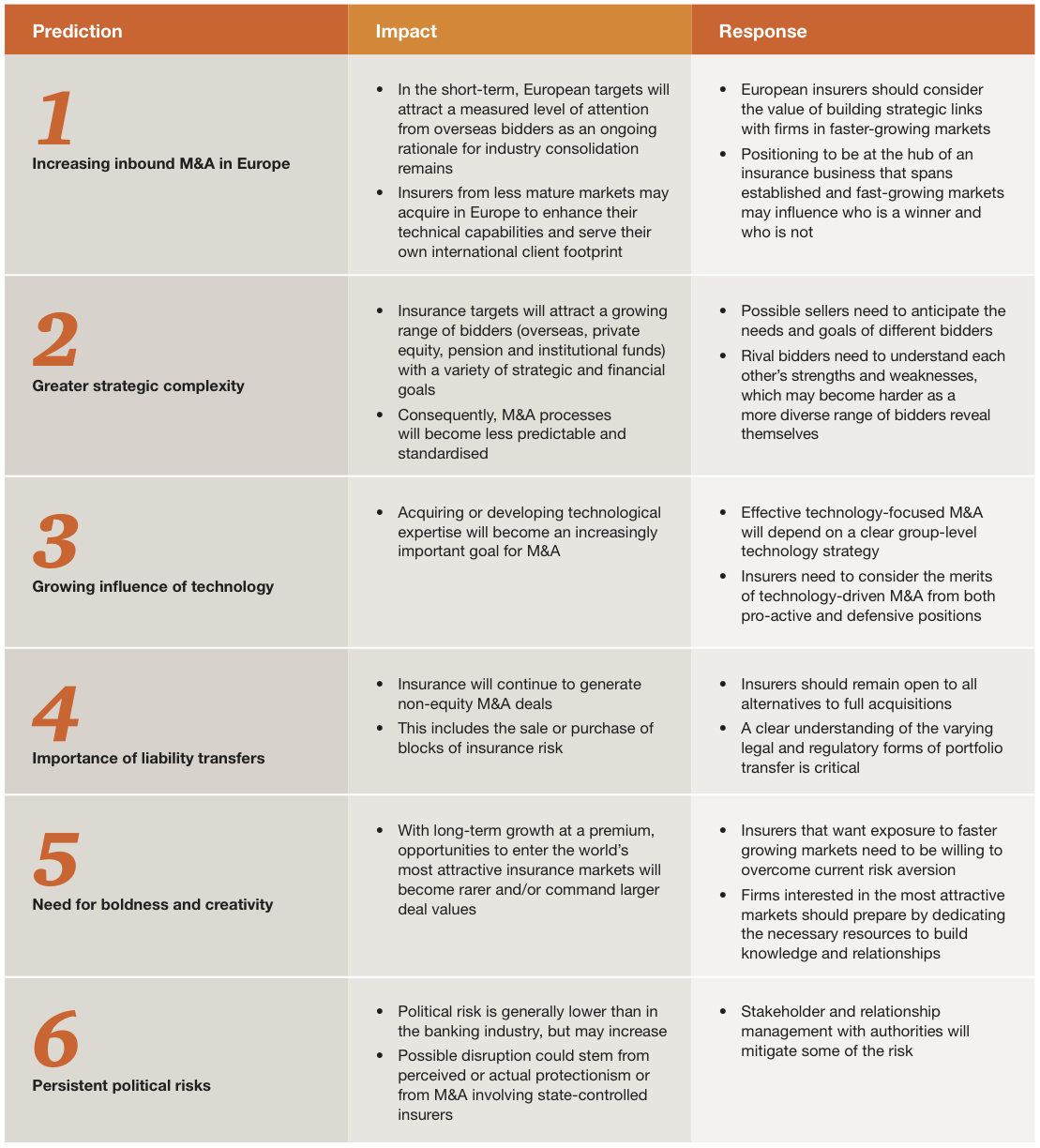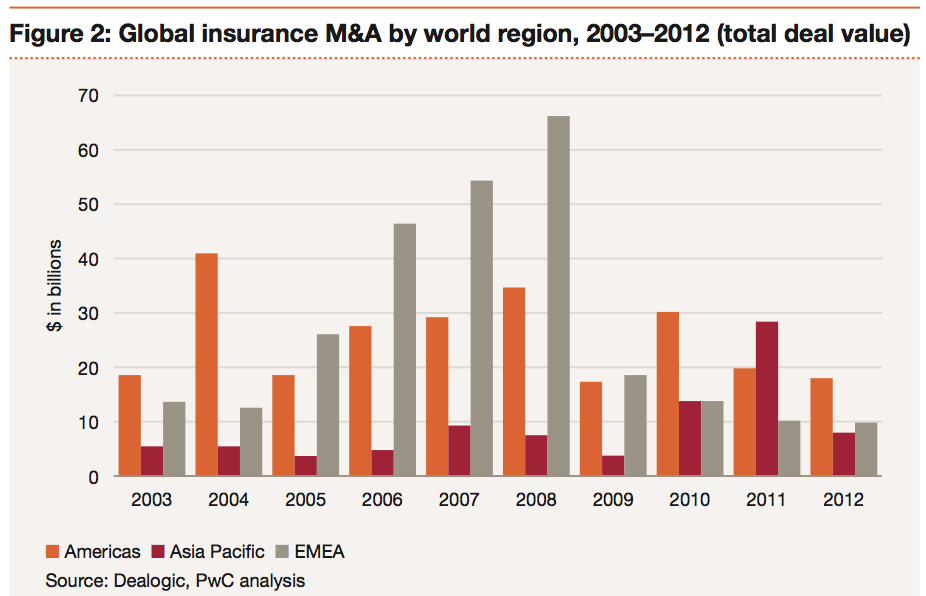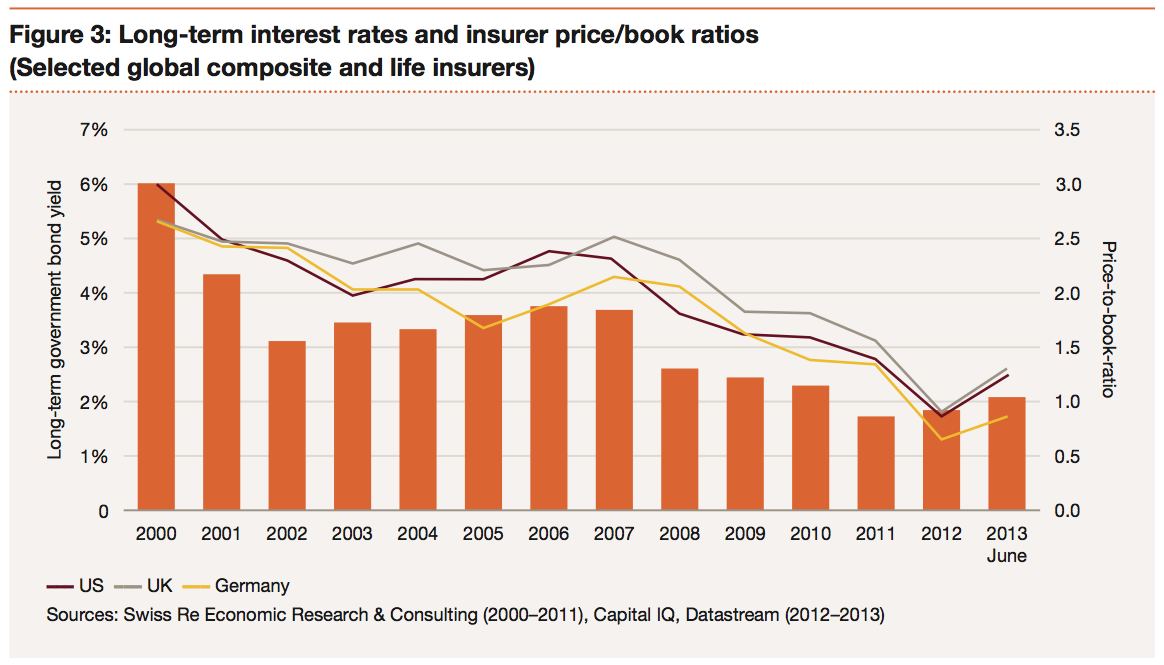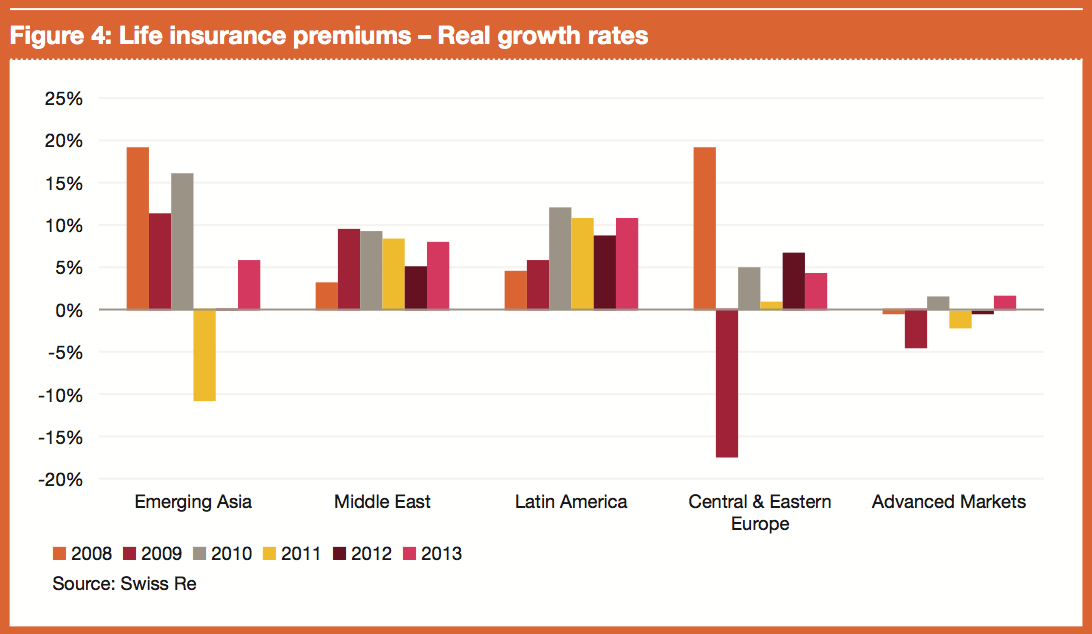
Executive summary
The global insurance industry’s outlook is improving. The mature economies of Europe and North America are moving towards recovery, while the emerging markets of Asia and Latin America continue to grow. A pickup in global premiums is forecast, but the industry should not expect a return to the old ways. Insurers are operating in a world where the goal of long-term growth seems to be getting further away. Instead, insurers face a range of obstacles including persistently low investment yields, tightening regulation and overcapacity in many markets.
As insurers adapt their business models to this new environment, the strategic importance of M&A is again increasing. However, we do not expect transaction volumes to recover along the same lines as during the last decade. Instead, we predict the next few years will see a quiet revolution in global insurance M&A.
From our analysis of the Global Insurance M&A market, we make six overarching predictions for the coming three to five years, and recommendations regarding how insurance organisations should respond (see table below).
In the rest of this paper we examine the economic, demographic, technological and regulatory factors driving change in insurance M&A. We also explore how M&A is already evolving in life, non-life and speciality insurance markets around the world. The themes we identify include the continuing appeal of scale and of fast-growing markets, but also the need for capital efficiency, the increasing role of technology and ‘big data’, the search for better pricing and the importance of effective distribution. And we take a close look at two hot topics: the increasing role of private equity and the growth prospects of Latin America.
If you would like to discuss any of our ideas in greater detail, please contact one of our specialists.
With sustainable growth getting harder to achieve, M&A is again taking on greater strategic importance. But the game is changing. Are you ready to profit from the coming revolution?
We do not expect transaction volumes to recover along the same lines as during the last decade. Instead, we predict the next few years will see a quiet revolution in global insurance M&A.

Introduction
How did we get here?
The financial crisis has had a clear effect on deal activity in the global insurance industry. A review of the past decade shows a steep fall in the volume and value of transactions after 2008 (Figure 1). Insurance M&A has fluctuated since then, but without regaining its previous momentum.
So has global insurance M&A gone from boom to bust? A closer look shows that the truth is more complex. The pre-crisis boom in insurance M&A was driven by EMEA and Western Europe in particular (Figure 2). The most active markets between 2005 and 2008 were the UK, the Netherlands, France, Italy, Switzerland and Scandinavia. In recent years this has reversed, with Europe hit hard by the financial crisis and uncertainty over the implementation of Solvency II.
In contrast, a steady flow of US transactions has helped deal activity in the Americas to remain comparatively stable. The years 2011 and 2012 were quiet, but there are signs of a recovery in 2013. Meanwhile, average levels of insurance M&A have increased in Asia-Pacific since the financial crisis.
As simple as it is, this analysis hints at the complexity of insurance M&A trends. In the rest of this paper we set out some predictions for the future of insurance M&A including drivers of change, current developments and future evolution. We conclude our analysis with some predictions for the global insurance M&A market.
Deal activity in Europe was hit hard by the financial crisis.


The new environment
What will drive insurance M&A?
Drawing on PwC’s Insurance 2020 framework, we believe several themes will play a particularly important role in shaping insurance M&A over the next five to ten years. In the short- to medium-term, low profitability will have a critical effect. Weak profitability is closely linked to low investment yields (Figure 3), and is encouraging insurers in mature markets to seek domestic deal synergies and to plan international expansion.
Set against that, low profitability is making it hard for many firms to raise capital. Many institutional investors would currently prefer insurers to concentrate on existing franchises rather than strategic deal-making. This is creating an atmosphere of risk-aversion where dividends are often more prized than future expansion.
There are three other factors that we believe will have more influence on insurance M&A over the next few years than is commonly realised.
- The power of technology: As the role of technology in insurance expands over the coming decade, its influence on M&A will grow rapidly. Automation and digitisation will become ever-more important to achieving efficiency. Insurers will also increasingly require technical expertise in areas such as data analytics, intelligent pricing, anti-fraud and telematics. M&A could provide the fastest way to improve in-house capabilities and counter the threat of new entrants. The hugely influential role of social networks and mobile technology will also drive transactions focused on improving distribution capabilities.
- Demographic effects: The demographic effects of ageing are not confined to developed markets. They will put increasing strain on social security programmes around the world, and could accelerate demand for life insurance, health insurance and long-term savings from current levels – even in emerging markets. Awareness of this issue is growing in China, for example. It has clear potential to influence strategic decision-making by insurers in both mature and developing markets.
- Changing hurdle rates: Many large insurers are struggling to deliver returns above their cost of capital, but firms often judge transactions against different hurdle rates, depending on their own internal forecasts, rates of return or cash-flow requirements. Japan’s recent history of very low base rates illustrates these potential variations. As investment yields change, transactions will be assessed against changing rates of return – leading to potential regional shifts in bidding power.
Weak profitability is closely linked to low investment yields, and is encouraging insurers in mature markets to seek domestic deal synergies and to plan international expansion.
Beyond these themes, insurance M&A will be moulded by the complex effects of economics and regulation. Economic themes include the shift of power away from developed economies, the threat of a renewed recession in Europe and the chance of market volatility creating deal opportunities. Regulatory trends include gradual harmonisation – seen in the IAIS’s anticipated adoption of Solvency II – but also disruption, illustrated by changes to Solvency II and the identification of global systemically important insurers.

General (non-life) insurance
General insurers around the world face some common challenges. Premium growth in developed markets is slowly recovering from 2010’s low, but remains restricted by slow economic growth. Aggressive competition, higher claims and weak investment yields are putting profitability under pressure. Growth is much stronger in developing regions, but even here, many insurers’ combined ratios are climbing.
Many general insurers are investing internally in intelligent pricing, but there will be increasing scope for firms to accelerate their progress by acquiring further expertise and proven platforms.
Scale will remain a strategic priority in many mature markets…
The search for greater scale remains a crucial strategic response to these challenges, and the drive for domestic consolidation will continue to shape global insurance M&A. In the US, where the growing cost of regulations such as Dodd-Frank are giving the appeal of scale a further boost, state regulators are unlikely to hinder the emergence of larger, financially stronger players. If the heavy losses of 2012 are followed by a hardening of rates, then some private equity funds could take the chance to exit previous Property & Casualty (P&C) investments, creating further deal opportunities.
In Europe, tough market conditions and rising compliance costs are also putting a premium on economies of scale. Non-core disposals by European banks and insurers will generate a stream of bolt-on targets for acquirers, but some general insurers will be prevented from making acquisitions by limited capital. Competition issues may also represent an obstacle in the region’s more concentrated markets. Fragmented markets are likely to see smaller insurers merging in the search for scale.
…And become increasingly important in Asia
Despite the comparatively rapid growth of Asia-Pacific general insurance, the dominance of motor means that profitability pressures are growing in a number of markets. As a result, scale will become an increasingly important driver of M&A, helping firms to generate cost synergies and invest in underwriting. Disposals by international groups will continue to give local and regional general insurers the chance to build scale, demonstrated by significant interest from the US and Europe in general insurance deals in South East Asia and China, where there are several processes under way.
Better product pricing will become a significant driver of M&A
General insurers that have already achieved economies of scale are increasingly turning to smarter pricing to improve their profitability. Some industry experts believe that European insurers could slice 2–3% off their combined ratios by emulating pricing best practice from markets such as the US or Australia. Over the next few years the ability to price individuals rather than groups of customers will become an increasingly important driver of M&A.
Several routes to smarter pricing could stimulate M&A. One is to develop the dynamic pricing capabilities needed to achieve profitable growth through aggregator websites and other electronic distribution channels. Another is to make greater use of telematics to aid pricing. This is most common in motor insurance, but telematics also has potential applications in other classes of business including across a range of commercial risks. A third option is to use the increasingly vast amount of customer information available to insurers – often referred to as ‘big data’ – as the basis for analysis, identifying which customers and which risks are worth competing hard for.
Many general insurers are investing internally in intelligent pricing, but there will be increasing scope for firms to accelerate their progress by acquiring further expertise and proven platforms. Deals like this have taken place before – typified by AXA’s purchase of Swiftcover – and there is clear potential for further transactions. In the longer term, M&A offers scope for insurers that have developed a competitive pricing edge to leverage those capabilities across a broader range of customers, or into entirely new markets.
Insurers with capital to spare will continue to target Asia and Latin America
General insurers that can afford to do so will continue to use M&A to acquire new customers. However, some of the insurers most in need of stronger growth are also among those limited by weak profitability or constrained by regulatory capital requirements. Many Western European insurance groups would like to increase their emerging markets’ exposure, but are currently unable to do so.
Even so, better capitalised firms in Europe and North America will continue to follow established routes into emerging markets in Asia-Pacific or Latin America. In some cases, they will take advantage of their peers’ withdrawals from the same markets. AXA’s recent acquisition of HSBC’s general insurance businesses in Hong Kong, Singapore and Mexico is an example.
Although expansion brings opportunities for growth, global insurers will need to guard against the potential risks that arise from greater complexity. Successful transactions between regions will need to balance the desire for geographic enlargement with effective central oversight and control.
Regional growth opportunities will also become more sought after
General insurers facing slow growth in their home markets will also become increasingly alert to less mature markets closer to home. In Asia, Japanese insurers – recently active as international bidders – will be joined by others seeking intraregional expansion. This process will be helped by the proximity of mature territories like Singapore and Hong Kong to faster growing markets such as Malaysia and China.
Similar patterns will emerge in Europe. As some Western European insurers withdraw from Central, Eastern and South Eastern Europe, others will increase their exposure to the region. Allianz’s recently announced acquisition of Yapi Kredi Sigorta will make it the largest insurer in Turkey. As international firms develop regional networks, physical and cultural proximity could help to deliver lower costs as well as higher growth.
‘Big data’ refers to the growing ability of insurers to harness the latent value of large and complex sources of customer information. This reflects the increasing availability of cost-efficient processing power, and the volume of data generated by customers’ online activity. In time, we expect the ability to derive insights from big data to be a key differentiator of success in personal lines.
Life insurance
Life insurance markets often have unique features, but life companies face many of the same challenges as general insurers. Premiums in mature markets are expected to return to modest growth from 2013, but low yields are squeezing profitability. Capital is also under pressure from progressively tougher solvency requirements. The picture in emerging markets is much more positive. Premium growth remains strong, and should improve further in Asia-Pacific, following a period of regulatory upheaval in China and India.
M&A dynamics will vary between concentrated markets like Italy and more fragmented ones such as Belgium. Changes to sales regulation, especially in the UK and the Netherlands, could also help to stimulate M&A.
M&A will continue to reshape the US life insurance market
As in general insurance, the desire to build scale will remain a popular strategy for life insurers in developed markets. This is particularly true in the US, where M&A among life insurers has the potential to accelerate. In-market deals will reshape the mortality and annuity markets, as insurers search for cost synergies and the benefits of diversification.
Recent transactions have involved a range of listed and mutual life insurers, underlining the scope for consolidation. This is illustrated by The Hartford’s recent sales of different businesses to the Prudential Insurance Company and Massachusetts Mutual Life. Life insurance M&A will also be fuelled by European insurers withdrawing from US businesses likely to become unattractive under Solvency II. Aviva’s sale of its US life and annuities business to Athene, one of 2012’s largest insurance deals, was one such transaction.
Private equity firms will play a growing role in US deals
Sales by foreign insurers may also help private equity funds to expand their exposure to US life insurance. Private equity firms will increasingly use their investment expertise to mitigate the effect of low interest rates and improve the spreads of fixed and indexed annuity portfolios. Guggenheim Partner’s acquisition of Sun Life’s US annuity business is an example of such a deal.
There are also growing signs of interest from private equity bidders in books of variable annuities. Many large life insurers would like to remove these contracts from their balance sheets, especially where reinsurance is costly or unavailable. Private equity investors could be more willing to take a long-term view, attracted by the potential to make a capital gain when interest rates pick up.
In Europe, capital will have complex effects on M&A
If capital pressures are important in the US, they are doubly so in Europe. Solvency II will not be implemented until 2016 at the earliest, but it will continue to encourage restructuring. This will apply particularly to firms whose ratings are under pressure from writedowns on Southern European government debt, guarantees issued before the financial crisis, or investments in distressed real estate markets.
But who are the potential buyers? Despite the scope for synergy gains, limited capital will prevent many domestic rivals from acting as consolidators. Market structure will also play a role: M&A dynamics will vary between concentrated markets like Italy and more fragmented ones such as Belgium. Changes to sales regulation, especially in the UK and the Netherlands, could also help to stimulate M&A. As in the US, private equity could become more interested in back books of annuities, currently clogging balance sheets.
Looking ahead, there is potential for more inbound Western European deals
In the short-term, inbound bids to Western Europe will remain rarer than in the last decade, when several US life insurers used M&A to expand in Europe. The losses sustained by Ping An following its investment in Fortis illustrate the potential risks, and other would-be buyers will be put off by low dividends and the complexities of European life insurance.
Even so, in the medium-term there will be growing potential for inbound M&A by Japanese, Korean or Middle Eastern life insurers looking to develop their in-house product expertise. Low valuations in Europe could also represent an investment opportunity for buyers willing to take a longer-term view of the European sector.
M&A in Asia-Pacific will be increasingly shaped by regional insurers
The retreat from Asia-Pacific by some international groups will continue to generate opportunities for M&A. The gradual introduction of more stringent regulation, especially in South-East Asian markets such as Indonesia, Thailand and Vietnam will further stimulate deals. Bidders will include a handful of well-capitalised global insurers, but local groups will be increasingly active. The next major Asian life insurers are likely to emerge from within the region. There is no lack of capital in the sector, and the importance of branding and reputation suggest that regional groups will use M&A to build on established distribution platforms.
The gradual ageing of Asian populations – a major theme in Japan, and an emerging one in Korea and China – will also drive transactions. Life insurers from developed markets will use M&A to leverage their sophisticated product expertise across the region. Asia-Pacific firms may also make acquisitions in developed markets to increase their capabilities in long-term savings or pension products.
Competition for Latin American targets will remain high
Life insurance M&A is likely to follow a slightly different pattern in Latin America. The region’s strong premium growth is highly attractive to foreign insurers, and as in Asia the potential for product evolution implies that international groups should harness their expertise to local acquisitions. Set against that, international groups are likely to find comparatively few opportunities to develop large-scale market positions through M&A. Instead, they will have to compete over businesses divested by other foreign groups. We explore Latin American life markets further.
Closed book consolidation will be an increasingly global driver of M&A
Closed book consolidation, long a strategic theme in markets such as the US and UK, will be an increasingly important driver of M&A in Europe during the next few years. Western European markets such as France and the Netherlands offer the chance for investors to create value by improving the back-office efficiency of businesses in run-off. It may even be possible for consolidators with a proven track record to roll up closed book acquisitions across several European markets, especially for similar types of product.
In the medium-term, emerging regions such as Asia-Pacific or Latin America offer much less scope for closed book consolidation than Europe. Run-off businesses in these markets are much smaller and insurers are typically more profitable and better capitalised. Even so, the potential for run-off deals in comparatively mature markets such as Korea and Chile will only increase in the longer term.
Changing attitudes to banking distribution will stimulate deals around the world
The differing fortunes of life insurers in mature and emerging markets will shake up strategic relationships between insurers and their banking partners. In Europe, the apparent decline of the bancassurance model will remain a driver of M&A. A combination of factors including regulatory rulings, strategic reviews and the anticipated effects of Basel III and Solvency II will keep encouraging banks to reduce their insurance assets and insurers to reassess banking joint ventures.
This trend will continue to stimulate disposals in markets including France, Spain and the UK. However, banks and life insurers in Italy will remain tied together by existing new business guarantees. If these contractual obligations can be removed, there may be scope for private equity bidders to buy out banks’ shares in these joint ventures.
In contrast to this picture of decline, major life insurers from mature markets will increase their strategic links with emerging markets’ banks. The recent partnership between the UK’s Prudential and Thanachart Bank of Thailand is a case in point. The dominance of banking distribution in many developing markets will see firms from the US, Western Europe and Japan forge partnerships with banks in South East Asia, South Eastern Europe or Latin America.
There is a sense that Latin America represents the last major untapped growth opportunity the industry is likely to see for the forseeable future
Latin America: The next battleground?
If there is one region currently generating more debate than any other in the life insurance industry, it is Latin America. Premium growth has been consistently strong over recent years (Figure 4), and this is expected to continue. There is a sense that Latin America represents the last major untapped growth opportunity the industry is likely to see for the foreseeable future.
Faced with slow growth in their home markets, life, general and composite insurers from North America and Europe are particularly keen to increase their exposure to Latin America. Brazil and Mexico are the region’s largest and most attractive markets, but every country has its own characteristics. The Chilean life industry is large and well-established, and countries such as Columbia and Peru offer exciting potential too.
International groups have some potential advantages as market entrants. As the Latin American middle class expands, demand for lifestyle products such as unemployment insurance or college savings’ plans will grow. This offers international groups a chance to leverage their experience in more sophisticated markets. International groups may also benefit from a lower cost of capital than local players. Regulatory attitudes to reputable international buyers are typically neutral.
However, international entrants will not have things all their own way. Most Latin American markets are already dominated by local groups, some of which are state controlled or privately owned. Meanwhile, listed insurers are often too big or too highly valued to make feasible takeover targets. Furthermore, most regional banks already have distribution partnerships with local insurers. These challenges are illustrated by the experience of international insurers in Brazil. A number of US, European, Japanese and Chinese firms already present in Brazil have struggled to increase their market shares through M&A.
This means that opportunism is likely to be the key to inorganic expansion in Latin America. High valuations will continue to tempt local and international groups to sell businesses in the region – as seen in BBVA’s disposal of its Chilean pensions’ business to MetLife, and Principal’s acquisition of Cuprum. However, local buyers will often have an advantage in terms of the synergies they can create.
If they are to make M&A in Latin America work, potential buyers from outside the region will need to demonstrate a combination of patience, flexibility and boldness.

Lloyd’s of London
The London Market has generated significant M&A activity over the past few years, and Lloyd’s vehicles continue to attract trade and private equity bids. The claims’ cycle has been instrumental, with targets ranging from vehicles pushed close to insolvency by the catastrophe losses of 2011 to highly valued syndicates following a benign 2012.
There are several reasons for this deal appetite – none of which look likely to change in the near future. The exposure of Lloyd’s vehicles is uncorrelated with most other risks, so they offer genuine diversification, something particularly attractive in the current environment. There is also the potential for high returns – many Lloyd’s vehicles have generated returns on investment of 15% or more in recent years, significantly above the traditional corporate market.
Lloyd’s vehicles offer some other unique attractions. Ownership of ‘underwriting years’ as a ‘name’ can allow investors to enter the market without necessarily assuming legacy liabilities or any operational involvement. Through its ‘Fund at Lloyd’s’ structure, Lloyd’s also offers considerable capital flexibility. For example, capital requirements can be met through letters of credit, something that is particularly attractive to financial investors.
Lloyd’s vehicles will therefore continue to attract bids from a range of potential buyers keen to enter the London Market. Insurers from other markets, especially the US, will remain active and Japanese firms could be potential buyers.
Private equity investors will also continue to buy Lloyd’s vehicles, hoping to emulate the experience of their peers – typified by CVC’s investment in Brit. Several funds have acquired managing agents and made significant efficiency gains by thinning out staff and focusing on a small group of highly experienced, well-remunerated underwriters. Depending on how these deals work out, the next two to three years could see a wave of secondary private equity transactions.
Finally, there is scope for further mergers between existing Lloyd’s managing agents. Greater scale offers the potential for better diversification, and the chance to share the growing burden of regulatory costs. M&A also offers a faster path to growth than organic expansion, which needs to be approved in advance by Lloyd’s.
With so much recent deal activity and such strong potential for further transactions, it is tempting to ask whether the current rate of M&A at Lloyd’s is sustainable. Although the influx of capital from so many new sources could imply a risk of over-valuation, this effect will be offset by the increase in underwriting capacity and a potential cooling of profitability. Deal activity in the Lloyd’s market is likely to remain strong for the foreseeable future.
Private equity funds will remain active bidders for insurance vehicles and brokers.
The increasing role of private equity
Private equity (PE) investors have long been attracted to the low capital requirements and scalability of insurance brokers, but are now increasingly willing to commit capital to a range of risk-carrying businesses. Our analysis suggests that PE funds will remain active bidders for Lloyd’s market vehicles and brokers. Private capital will also develop greater appetite for unwanted blocks of annuities in North America, Europe and Japan.
This trend is about more than matching cash-rich funds with capital-constrained insurers. PE investors believe they are well-placed to create value from unprofitable books of business by using their investment expertise. The successful track record of some firms in improving the operational efficiency of insurance businesses is further boosting their confidence.
Of course, PE funds have their limitations, not least the amount of capital at their disposal. Some potential deals will also remain restricted to an existing insurance entity with established regulatory oversight.
Nonetheless, PE investors have some advantages over trade buyers. Private funds have fewer stakeholders to satisfy than strategic acquirers; they can afford to take a longer term view than listed insurers; they typically have fewer internal hurdles to clear before making an investment; and they are usually able to make quicker ‘go/no go’ decisions based on purely financial criteria. This can allow PE bidders to take the initiative over strategic buyers in a bidding process.
Regulatory attitudes are a different matter. Regulators around the world have often taken the view that PE funds are unsuitable owners for long-term life insurance contracts. Political sensitivities mean that PE ownership is likely to remain a delicate issue in many markets. This is particularly true in Asia, but US state regulators are also taking an increasing interest in PE ownership of annuity businesses. Even so, the recent approval of PE bids for general and closed life targets in a wide range of markets suggests that attitudes are beginning to change. Over time we expect regulatory attitudes towards PE ownership to soften further.
In our view, the role of private equity in global insurance M&A is only likely to grow.
Conclusion: A quiet revolution
We conclude our analysis of current and future developments in global insurance M&A with some overarching predictions for the next three to five years. We expect the future of insurance M&A to be shaped by a growing range of strategic and operational imperatives. Deal patterns will not change entirely but they will continue to increase in complexity, combining new strategic priorities with established themes. Global insurance M&A is about to undergo a quiet revolution.
Increasing inbound European M&A Europe will see comparatively modest inbound M&A in the short-term, but as the significance of long-term trends in insurance become clearer the region will see increasing inbound investment. Insurers from Asia-Pacific, the Middle East and other developing markets will acquire European businesses in search of greater expertise.
Greater strategic complexity
Changing patterns of M&A will increasingly see different types of bidder – global insurers, regional and local firms, private equity funds, sovereign investors and others – competing for the same target. Understanding other bidders’ goals, priorities, assumptions, hurdle rates and obstacles will become more important to successful M&A.
Growing influence of technology
Technology will play an increasingly important role in insurance deal-making. Insurers will acquire technological expertise, in part as a defensive strategy against disruptive new entrants. Communication or social networking companies could also use M&A to acquire an insurance vehicle and combine it with their high levels of customer insight and trust.
Importance of liability transfers
Insurance will remain a sector where the desire to transfer liabilities on and off balance sheet generates alternatives to ‘traditional’ M&A transactions. These include IPOs and asset swaps, but also major reinsurance agreements which effectively shift large blocks of assets and liabilities between counterparties, without necessarily involving the sale of purchase of a legal entity.
Need for boldness and creativity
International groups looking for growth will need to strike a better balance between the need for short-term stability and the benefits of long-term expansion. As well as a willingness to take bold decisions, foreign insurers hoping to expand in emerging markets will increasingly need to build relationships, think creatively and work with a wider range of stakeholders.
Persistent political risks
Insurers contemplating inorganic expansion should remember that political risks are not confined to the banking industry. In the medium- to long-term political effects on insurance M&A might include the sale or break-up of nationalised insurers, intervention in systemically important insurers, restrictions on the sale of insurance assets or greater protectionism.
Gradual global restructuring
Global insurance M&A will continue to generate a steady flow of mid-market transactions, punctuated by the occasional large-cap deal. Over time, M&A will see insurers sort themselves into three groups: Large international insurers with deep technical and financial resources; local and regional firms with distribution-led strategies; and niche players specialising in particular products or customers.
The largest groups will need to match geographic complexity with strategic clarity if they want to avoid a subsequent retreat from their global models.







